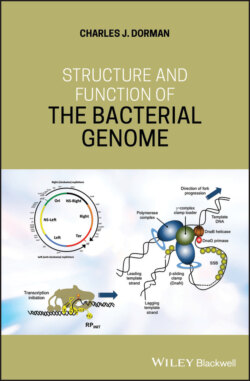Читать книгу Structure and Function of the Bacterial Genome - Charles J. Dorman - Страница 64
1.53 The Leucine‐responsive Regulatory Protein, LRP
ОглавлениеThe leucine‐responsive regulatory protein (LRP) DNA‐binding protein affects the expression of about 10% of the protein‐encoding genes in E. coli, many of which are involved in determining the structure of the bacterial surface, in transport, in metabolism, and in adaptation to stationary phase (Cho, B.K., et al. 2008, 2011; Engstrom and Mobley 2016; Tani et al. 2002). More recent data, based on ChIP‐seq and RNA‐seq analyses, have led to a revision of the estimate of LRP's influence to up to 38% of the E. coli genome (Kroner et al. 2019). In many cases, LRP interacts with target promoters in a poised mode, not influencing promoter activity until it operates in combination with other regulatory proteins; it also shifts between more‐ and less‐sequence specific DNA‐binding modes in response to nutrient signals (Kroner et al. 2019).
LRP contributes to the genetic switches that govern the phase‐variable expression of Pap and type 1 fimbriae in E. coli (and fimbriae in Salmonella), linking LRP to bacterial virulence and to biofilm formation (Aviv et al. 2017; Hernday et al. 2004; Kelly et al. 2009; Lahooti et al. 2005; McFarland et al. 2008). LRP is also a regulator of the stpA gene, encoding the H‐NS paralogue StpA that is both a DNA‐ and an RNA‐binding protein (Free and Dorman 1997; Sonden and Uhlin 1996). Together with StpA (and with H‐NS and FIS) LRP controls the transcription of rsd, the gene encoding the Rsd anti‐sigma factor that targets RpoD and, to a lesser extent, RpoS (Hofmann et al. 2011). These links confer on LRP the potential to influence transcription patterns throughout the genome.
The 18.8‐kDa LRP monomer forms octamers and hexadecamers and has the ability to wrap, bend, and bridge DNA (Chen et al. 2001); the B. subtilis homologue, LrpC, forms structures with DNA that are reminiscent of a eukaryotic histone core (Beloin et al. 2003b). LRP expression peaks at the transition from the exponential phase to the stationary phase of the growth cycle in rapidly growing E. coli (Landgraf et al. 1996). In keeping with its name, the interactions of LRP with its target genes can be potentiated, inhibited, or unaffected by leucine and other branched‐chain amino acids (Calvo and Matthews 1994; Lahooti et al. 2005; Peterson and Reich 2010). Leucine can also influence the oligomeric state of LRP, perhaps helping to explain the distinct effects (including no effects) that branched chain amino acids can have on different LRP regulated systems.
The LRP protein competes with the Dam methylase for access to two 5′‐GATC‐3′ sites in the pap and pef fimbrial operons of uropathogenic E. coli and Salmonella, respectively. This outcome of competition decides if the Dam sites will be methylated or not and this, in turn, determines if the fimbrial structural genes will be transcribed or not. The result is a stochastic switch that is reset by the synthesis of hemimethylated DNA during chromosome (pap) or virulence plasmid (pef) replication (Hernday et al. 2002; Nicholson and Low 2000). In contrast, LRP acts as a directionality determinant at the invertible fimS genetic switch that governs the phase‐variable expression of type 1 fimbriae in E. coli, an inversion event that is catalysed by two tyrosine integrases, FimB and FimE (Corcoran and Dorman 2009; Kelly et al. 2006). In the case of pap/pef, LRP is acting as a DNA‐binding protein in competition with a DNA modifying enzyme; in the case of fimS, LRP's ability to shape DNA is likely to be influencing the directionality of the On/Off invertible genetic switch. It also plays a role in virulence in M. tuberculosis by modulating the innate immune response of macrophage (Liu and Cai 2018). These examples illustrate the versatility of the LRP protein and its ability to influence diverse systems by different molecular mechanisms.
